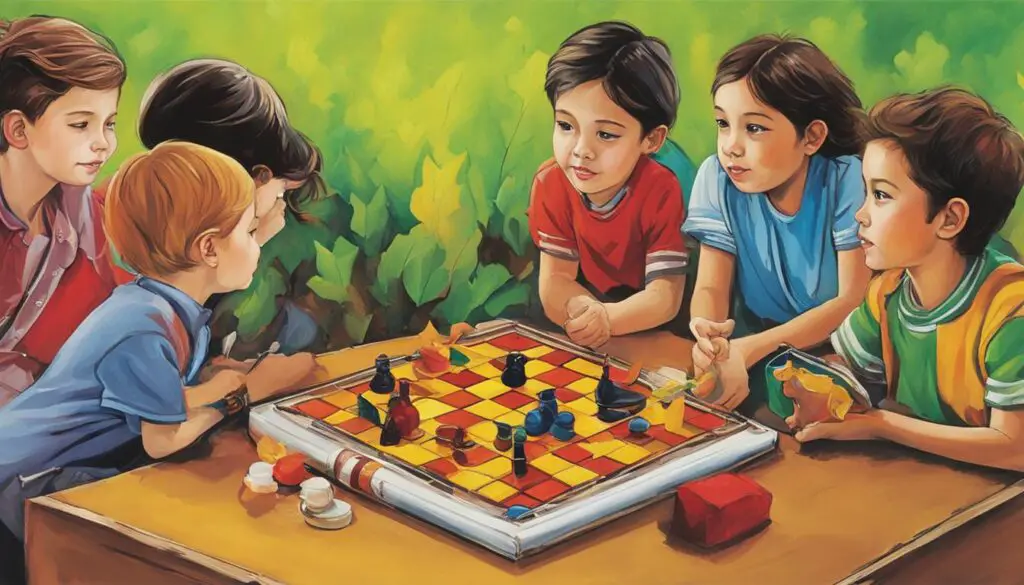
Helping Your Child Handle Peer Pressure
As a parent, I understand the concerns and challenges that come with helping your child navigate peer pressure. It can be a daunting task to ensure they make confident decisions and stay true to their values amidst social influences. However, with the right advice and strategies, you can empower your child to handle peer pressure effectively.
Key Takeaways:
- Understand the impact of peer pressure on children’s behaviors, choices, and self-esteem.
- Recognize the different types of peer pressure, such as direct and indirect influences.
- Communicate openly with your child to understand their concerns and experiences.
- Encourage assertiveness skills to help your child make decisions based on their own values.
- Guide your child in setting boundaries, developing self-confidence, and building a supportive network of friends.
The Impact of Peer Pressure on Children
Peer pressure can have various effects on children. It can influence their behaviors, choices, and even their self-esteem. It is important to recognize that peer pressure can be both positive and negative. Positive peer pressure encourages children to engage in healthy activities and make positive choices. It can motivate them to excel academically, participate in extracurricular activities, and develop healthy habits. For example, if a child’s peers are involved in sports or music, they may feel inspired to pursue those interests as well. Positive peer pressure can foster a sense of belonging and help children navigate social situations with confidence.
Negative peer pressure, on the other hand, can lead to risky behaviors and compromised decision-making. Children may feel pressured to engage in activities that go against their personal values or beliefs. This can include experimenting with drugs or alcohol, engaging in bullying behavior, or participating in other harmful activities. Negative peer pressure can cause children to feel isolated, stressed, and anxious. It can also contribute to low self-esteem, as they may feel the need to conform to fit in with their peers.
“Peer pressure can be incredibly influential in shaping a child’s behavior. As parents, it’s important for us to stay connected and open the lines of communication with our children, so that we can guide them through the challenges and help them make choices that align with their values.”
To fully understand the impact of peer pressure on children, it is crucial to explore both the positive and negative aspects. By doing so, parents can better equip themselves to support their children in navigating social pressures and making informed decisions.
The Effects of Peer Pressure on Children:
- Influences behavior and choices
- Affects self-esteem and sense of identity
- Can lead to both positive and negative outcomes
- Shapes social interactions and relationships
Understanding Different Types of Peer Pressure
Peer pressure can manifest in various ways, and it’s essential for parents to be aware of these different types to help their children navigate social situations effectively. Two significant types of peer pressure are direct peer pressure and indirect peer pressure.
Direct Peer Pressure
Direct peer pressure involves explicit requests or demands from peers for children to engage in certain behaviors. This type of peer pressure can be overt and straightforward, leaving children feeling pressured to conform to their peers’ expectations.
“Hey, everyone’s doing it. Why don’t you join us?”
Example: Imagine your child’s friends are pressuring them to skip school or engage in risky behavior. Direct peer pressure is explicitly asking your child to participate in these activities, making it more challenging for them to resist.
Indirect Peer Pressure
Indirect peer pressure involves subtle influence and persuasion from peers. Unlike direct peer pressure, indirect peer pressure may be more insidious and harder to identify. It can come in the form of passive comments, nonverbal cues, or the anticipation of social consequences for not conforming.
“I heard Amy got invited to the party because she agrees with everything the popular kids say.”
Example: Your child’s friends may indirectly pressure them by talking about how their popularity or social standing increases when they conform to certain norms. This can make your child feel inclined to adopt similar behaviors to fit in.
By understanding these different types of peer pressure, parents can better equip their children to recognize and respond appropriately in various social situations.

A Comparison of Direct and Indirect Peer Pressure
| Aspect | Direct Peer Pressure | Indirect Peer Pressure |
|---|---|---|
| Communication | Explicit requests or demands | Subtle influence and persuasion |
| Pressure Style | Overt and straightforward | Indirect and insidious |
| Identifiability | Clear and explicit | May be harder to identify |
| Response Challenges | May create direct conflict | May create internal conflict |
Tips for Helping Your Child Handle Peer Pressure
When it comes to helping your child navigate peer pressure, there are several effective strategies you can employ as a parent. By implementing these tips, you can empower your child to make confident decisions based on their own values and beliefs, while also fostering open communication and assertiveness skills.
1. Communicate Openly with Your Child
Open communication is key to understanding your child’s concerns and experiences with peer pressure. Create a safe and non-judgmental space where your child feels comfortable sharing their thoughts and feelings. Actively listen to their concerns and validate their emotions. This will help them feel supported and more likely to seek guidance from you when faced with difficult situations.
2. Encourage Assertiveness
Teach your child how to assert themselves effectively by encouraging open and honest communication. Help them practice expressing their opinions, preferences, and boundaries in a respectful manner. Role-play different scenarios to equip them with the skills to say “no” when they feel pressured to engage in behavior that goes against their values. By empowering your child to assert themselves, you are arming them with the confidence to make decisions that align with their personal beliefs.
3. Set Boundaries and Foster Self-Confidence
Work with your child to establish clear boundaries and guidelines for their behavior. By setting expectations and limits, you provide them with a framework to make responsible choices. Additionally, focus on building their self-confidence and self-esteem. Encourage their unique strengths and interests, and remind them of their worth. A strong sense of self will make it easier for your child to resist negative peer pressure and make choices that align with their values.
4. Build a Supportive Network of Friends
Encourage your child to develop meaningful friendships with individuals who share similar values and interests. Surrounding themselves with a supportive network of friends can provide a sense of belonging and camaraderie, making it easier to resist negative peer pressure. Help them identify positive role models and encourage healthy social interactions.
“Open communication, assertiveness, setting boundaries, and a supportive network of friends are all crucial elements in helping your child handle peer pressure effectively.” – [Parenting Expert]
| Tips for Helping Your Child Handle Peer Pressure | |
|---|---|
| Communicate openly with your child | Encourage them to share their concerns and experiences |
| Encourage assertiveness | Teach them to express opinions, preferences, and boundaries |
| Set boundaries and foster self-confidence | Establish guidelines and build their self-esteem |
| Build a supportive network of friends | Encourage positive social connections |
Implementing these strategies will empower your child to navigate peer pressure with confidence, helping them make choices that align with their values and beliefs. By fostering open communication, assertiveness, and a supportive environment, you can equip your child with the tools they need to handle peer pressure effectively.

Conclusion
Handling peer pressure as a parent can be a challenging task, but it is essential for the well-being of your child. By taking a proactive approach and providing guidance, you can empower your child to navigate social pressures with confidence.
Fostering open communication is key to understanding your child’s concerns and experiences. Encourage them to share their feelings and struggles without judgment, creating a safe space for dialogue. By listening actively and empathetically, you can provide the support and guidance they need.
In addition, promoting assertiveness skills is crucial. Teach your child to stand up for themselves and make decisions based on their values and beliefs. Encourage them to say “no” when they are uncomfortable and support their choices.
Lastly, provide guidance on setting boundaries, developing self-confidence, and building a supportive network of friends. Help them understand the importance of surrounding themselves with positive influences and foster healthy relationships.
By implementing these strategies and offering the right support, you can help your child develop the resilience and self-assurance needed to navigate peer pressure effectively. Remember, handling peer pressure is a continuous process, and your role as a parent is essential in guiding them towards making positive choices.
FAQ
How can I help my child handle peer pressure?
You can help your child handle peer pressure by fostering open communication, encouraging assertiveness, and providing guidance on setting boundaries.
What are the effects of peer pressure on children?
Peer pressure can influence children’s behaviors, choices, and even their self-esteem. It can have both positive and negative effects, depending on the nature of the peer pressure.
What are the different types of peer pressure?
There are two types of peer pressure: direct peer pressure, which involves explicit requests or demands from peers, and indirect peer pressure, which involves subtle influence and persuasion from peers.
How can I communicate openly with my child about peer pressure?
To communicate openly with your child about peer pressure, create a safe and non-judgmental space for them to express their concerns and experiences. Encourage them to share their feelings and thoughts without fear of criticism.
How can I encourage assertiveness in my child?
You can encourage assertiveness in your child by teaching them effective communication skills, helping them identify their values and beliefs, and empowering them to make decisions based on those values.
Source Links
- https://www.scientificamerican.com/article/sand-mafias-are-plundering-the-earth/
- https://timesofindia.com/life-style/parenting/moments/ours-is-an-unconventional-family-but-a-happy-one-single-dad-tusshar-kapoor/articleshow/106818622.cms
- https://www.psychologytoday.com/au/blog/indispensable-thinking/202401/leaders-dont-substitute-your-feelings-of-fear-for-anger